One Cup At A Time

Last week I moved to San Francisco.
But that’s another story.
Instead, I wanted to write down my thoughts on Philz coffee.
To explain Philz, you need to understand the American coffee scene. It’s all over the place, but it can be loosely defined in ‘waves’. Here’s Jonathon Gold:
The first wave of American coffee culture was probably the 19th-century surge that put Folgers on every table, and the second was the proliferation, starting in the 1960s at Peet’s and moving smartly through the Starbucks grande decaf latte, of espresso drinks and regionally labeled coffee. We are now in the third wave of coffee connoisseurship, where beans are sourced from farms instead of countries, roasting is about bringing out rather than incinerating the unique characteristics of each bean, and the flavor is clean and hard and pure.
Coming from Australia, I’ve been amused by every aspect of American coffee culture. Despite the hype, care and craft that goes into a cup of joe at a ‘third wave’ chain like Blue Bottle, I find the whole experience lacking and soulless. In fact, if I was ordering from a chain (instead of a local cafe), I’d prefer the happy bustle of a Starbucks. Their espresso’s (I order a doppio machiato) are decent, and always taste exactly the same, and the stores have energy and warmth.
Blue Bottle in comparison feels like a miniature apple store, with white walls, minimal menu, and delicate branding. The coffee has become this ultra stylized product, that should be cradled and respected and photographed. I think they’re missing the point.
So when I finally wandered into a Philz, which are all over SF, I was prepared for more of the same.
It wasn’t.
Here are some of the ways that Philz stands out.
• They focus on drip coffee. That’s it. They do drip coffee really well, and nothing else. They literally don’t serve espresso at any stores. There’s no frothing milk or screech or hiss or whack of the filter. This is the most important part of their brand. Textbook positioning.
• Bartenders not baristas. Rather than a cashier who takes your order, and a separate barista station, there is a long bar of baristas, each of them stirring and brewing about 4 individual cups each. The ordering process is reversed, so a barista will take your order, and you pay once you’ve got your coffee. This is much more like ordering a drink at a nice cocktail bar than a cafe. I’d be interested to know how throughput is affected, but the customer experience is fantastic.
• They walk their talk. Their tagline “one cup at a time” is baked into the process. My barista asked me to make sure my coffee was “perfect for me” before I paid for it. This confused me, but later I understood that everything about the Philz transaction was centered around personalization. Here’s an obvious insight: Everyone likes their coffee different ways. Black, two sugars, oat milk, half and half.. But rather than viewing these small tweaks as blasphemous, annoying or disrespectful to the skills of the barista, Philz embraces it. It’s one cup of coffee, and we will make it the way you like it. Simple as that. And arguably, it’s not all about taste in the end is it? Rather, how you feel you were treated. Consider a sommelier who quietly pours the wine you’ve chosen out of a unmarked jug. How would you feel about that? It’s the same wine, or is it? Buying Philz is not just getting a coffee, it’s getting a bit of attention, getting treated nicely, listened to.
• Another motif from their branding that is reflected in their stores is the mint leaf. I ordered a Turkish coffee and got a sprig of mint in my cup. When I paid, I asked if all coffees got the mint treatment. “Only if the coffee has a little leaf next to it. But we can put it in any coffee you’d like.” Again with the personalization. Personally, I didn’t love the mint flavour, but it was an interesting, memorable visual, and another quirk that made Philz just a little bit more different than another chain.
—-
Bottom line. I’d never heard of Philz before I moved to SF. From the outside, I thought the branding was a bit ‘crunchy’ and expected a bog average Peets or Starbucks imitator. Instead, I saw a coffee company doing things very differently and building a long lasting, strong brand. From ordering a cup, to my first sip, I immediately understood the appeal, and was impressed by a brand that was super consistent in its message and product. It’s dorky, but it will easily outlive Blue Bottle.
Designers should write more
I enjoyed Zac’s post on capturing thoughts, ideas and anything else that helps you make smarter decisions at work. Check it out.
Here’s my system, if you can call it that. If you’re interested in improving your knowledge game, I’d recommend nearly anything that Tiago Forte does. Start with his Progressive Summarization series and follow him on twitter.
Notes.app / Paper
For me, this is the rawest stage of thinking and documentation (after talking, where I formulate a lot of my thoughts, which is a weakness). This is a firehose of anything that I deem worthy of writing down, and it usually only sticks around for a few days before it’s archived, deleted or transferred elsewhere. I like to manage my notes app inbox zero style, clearing out anything that shouldn’t be there. Survival of the fittest. Of course, I still jot down to-do lists and ideas on paper, but increasingly I like everything to be digital. If I’m reading a paper book, I’ll start a new note and log passages, ideas and page numbers that I like. I really should be using google docs or evernote for this sort of thing.Trello
A trello/kanban board is an essential tool to visualize and order anything that I think will eventually become an actionable item. WIP. This is where a ‘idea’ might become a project, or a blog post, or a calendar entry. I roughly follow the GTD system and it maps very nicely with the trello board.Keynote playbook
This is embarrassing to admit, but I store my most valuable, useful thoughts and information in a series of keynotes, that live locally on my mac. I drop text, links, sketches and diagrams into these decks, roughly organized into under topics like ‘usability’ or ‘user research’. The searchability is non-existent, they are incredibly disorganized and I’m sure there’s a lot of redundant information, but I love them. Eventually I’ll switch to a different system. Aside from acting like a second brain, what I found most helpful was documenting moments when a new or complicated concept ‘clicked’. It could be a intuitive mental model, a framework, a diagram, or even a quote that made me think differently. I might then annotate that, essentially re-writing it or explaining it language that was mine. Then I could confidently return to eg. an explanation of how CSS Grid works, and build off it or apply it to active or future projects.
Aside from an incredibly valuable paper trail, I see most of this stuff as weaponry to deploy the next time you need to communicate an idea, persuade someone or formulate an argument. That’s why it’s worth all the writing.
A surfing lesson in Byron Bay

“You can call me Gaz, but my kids call me Shrek. That’s because I’m usually pretty nice, but I can be an ogre.”
I had no idea how old Gaz was. But after a few minutes riding in his van to the beach, I knew a couple of facts about him.
- He was a surf instructor.
- He’d been surfing for 45 years.
- His face, made of “crocodile skin” didn’t seem to make sense without his black, wrap-around sunglasses, that he rarely removed.
And it was Gaz’s surf lesson. When we arrived at the beach, he handed us forms to sign, faded rash-vests to wear, and boards to carry. There wasn’t time to wonder if you could learn to surf. Our group of 6 was rushed from car park to sand to water.
An introductory surf lesson, like anything else that’s repeated often (a health and safety demo, a house tour, a sales pitch), has been optimized over time. This is a defining characteristic. There’s an invisible schedule, a structure, that you respond to. The jokes feel tired, but they are tried and tested, and they’re deployed for a reason. Over years, a formula emerges. Gaz reads the crowd, tests for age, sensitivity, existing dynamics (eg. partners, friends, strangers), and selects from his tool kit. It’s fascinating to see this well oiled, and well tanned machine in action.
With the boards laid out on the sand in a row, he explains some fundamentals. The side of the surfboard is the rails. The front is the nose. The back is the tail. We lie down, prone, and he draws a line of wax infant of our noses. “This is where your nose should be. Some instructors will tell you to line up the tail of board with your feet. They’re a bunch of wankers.” To Gaz, all other surf schools and instructors were wankers.
After jumping to our feet a few times (faster, faster!), we knelt in a circle and he used “google sand” to show how the ocean works. Currents, waves, rips. Where to paddle. Where to surf. He seemed particularly annoyed by the popular belief that rips were dangerous, something he attributed to surf life saving Australia. “Rips are only dangerous if you swim against them. They take you out to where the waves break. Rips are good.”
I signed up for this lesson with a fair amount of hesitation. My natural instinct would be to rent a board for myself and struggle at it alone. Here’s a few reasons why I liked it.
Firstly, and most importantly, a good instructor makes a hell of a difference. A good instructor can get in the shoes of a beginner, and can quickly squeeze out results. He’s heard every excuse. He knows exactly what’s possible. He knows what cues, like “banana”, are simple enough to get your body to do what it’s supposed to do (biomechanics, theory and form aside, there’s no time for that). He also was naturally “high status”. By status, I don’t mean social status, but the status dynamics that exist within any interpersonal interactions. As socialized humans we are always adjusting our status in relation to the people or spaces that we interact with. A teacher naturally has a higher status than students, but is not always the case. This is important, as a low status teacher (think about someone who is bumbling, self doubting, frustrated, clumsy, eccentric), can quickly lose the favor of the group. Gaz rewarded behavior he liked, and quickly extinguished anything that questioned his power and control.
Secondly, it couldn’t have been a better wave to learn on. “The Pass”, was a gentle, spilling right hander. It was shallow. We waded out to the break, and it felt like the waves had been dialed down in power to about a 2 out of 10. Just enough to push you towards the beach. The Pass is considered one of the best places to surf in Australia, and after splashing around for 30 minutes, I could see why.
Lastly, we had a good group. That makes a difference. I quickly bonded with Sarah and P.G, two Berliners living in Australia for different reasons. P.G was a smiling Italian, covered in tattoos and “used to have dreadlocks, when I was an anarchist”. Sarah, was a little more reserved and tougher looking, with a shaved undercut, and was originally from Belgium. After the lesson, we ate rare kangaroo and got drunk on light colored beer. Isn’t that how every surfing lesson should end?
Nonrational Packaging Design in the 1950′s
Notes from The Hidden Persuaders - Vance Packard (1957).
Good Luck Margarine
While a competitor can often successfully imitate your product as to ingredients and claims of quality, a vivid personality image brand is much more difficult to imitate and so can be a more trustworthy sales factor. A fairly simple, straightforward use of non-rational symbolism in image building was Louis Cheskin’s transformation of the Good Luck margarine package. The package originally contained several elements, including a picture of the margarine. In one corner was a little four-leaf clover. Mr. Cheskin found in his depth probing user research that the four-leaf clover was “a wonderful image” so in three successive changes iterations he brought it more and more prominence until finally he had a simple foil package completely dominated by a large three dimensional four-leaf clover. Mr. Cheskin reports that sales kpi’s rose with each change.
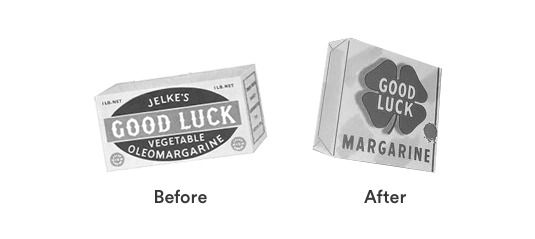
Fleischmann’s Gin
Fleischmann’s Gin, in seeking to cope with the sexual revolution, turned to Louis Cheskin for guidance. He suggested a slight change in the label design which probably wasn’t even noticed by the average buyer but which, he claims, distinctly modified its sex appeal and brought a great increase in business for the company. The old label was a plain rectangle with sharp right-angle corners. Mr Cheskin merely rounded the corners, which reportedly made the label more feminine.

In these examples, the insights (pop psychology + a fair whack of 50′s sexism) and data (Mr. Cheskins trusty ‘reports’) are shaky.
But the thinking is in the right direction. With each update to the design, he’s building the brand. Making it more distinctive, memorable and differentiated from competitors.
February 16, 2018 psychology sales marketing advertising research data design
Add to Upcoming AmazonFresh Delivery
• Concepts explain how software works.
• These concepts help build and explain a complex system.
• For example, Twitter would be pretty hard to explain without mentioning ‘hashtags’ or ‘following’. These are concepts.
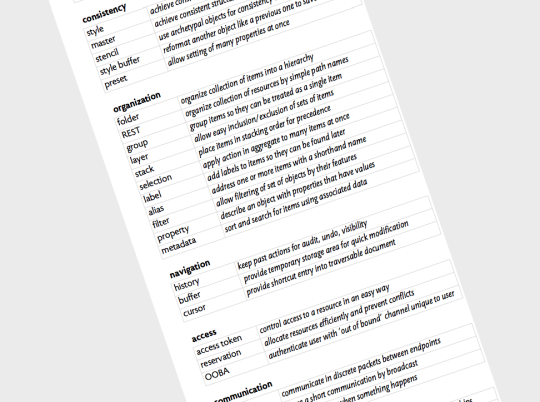
A list of concepts and purposes. By Daniel Jackson
• Let’s look at online shopping carts. Carts have existed about as long as internet businesses have been around. Since the mid 90′s.
• The concept of a cart is quite simple, and maps closely to it’s real-life counterpart.
• You can explain concepts with an operational principle. “If you add an item to cart, it is moved to a special list. You can then review, edit, remove, add items to this list before deciding to order them.
Introducing Amazon Fresh
• When Amazon introduced AmazonFresh, a grocery delivery service, they had to think of a way for it to play nicely with the existing shopping cart.
• With AmazonFresh, you are actually adding to an ‘order’. Because you are ordering perishable foods, it’s important for the food to be delivered (attended or unattended) within a time window. These differences mean that you can’t mix up the fresh food and the books.
• Here’s how Amazon explains it. Fresh items are added to the Fresh cart, separate from other Amazon.com items. If you have items in your Amazon shopping cart and Fresh shopping cart, you’ll see the option to Checkout Fresh Cart or Proceed to Checkout, respectively. This will create two separate orders for your deliveries and as a result you will need to checkout each cart separately.
• Amazon uses a few different techniques to enforce this seperation.
• Different colored buttons
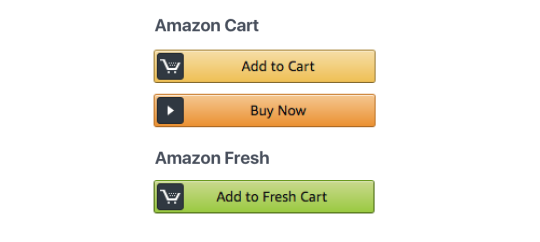
• Visually separate carts
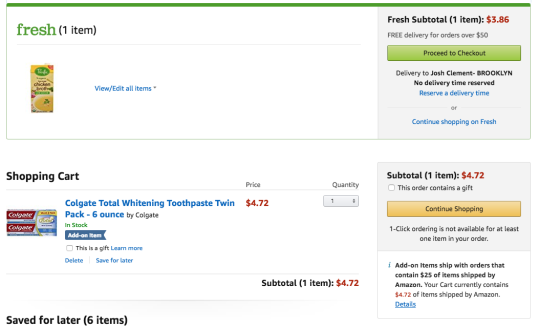
• But in some cases, Amazon displays a combined cart, like here in their top nav. I’ve added 1 item to shopping cart, and 1 item to fresh cart, and the number 2 is displayed. At this low level of detail, it doesn’t make sense to clutter the bar with multiple carts.
![]()
• Some items, like hand soap, are able to be added to both carts. Amazon uses a logo next to the price to communicate the different store.
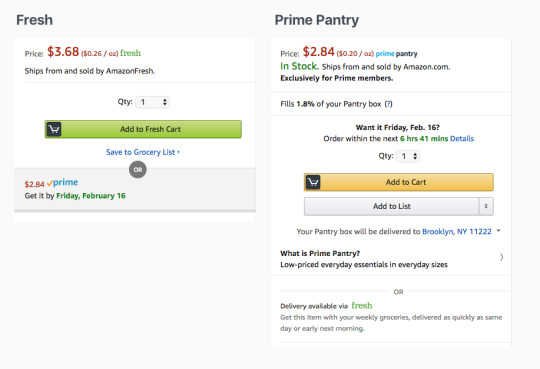
Post-Order
• You add your items to the fresh cart. You place your fresh order. Amazon receives your order. It’s schedule for tomorrow evening, between 8pm and 10pm. Great.
• But what if I schedule an order, but want to add something else?
• You’re in luck.You can add items to an upcoming AmazonFresh order if it hasn’t already been prepared.
But how do you design for this?
The challenge is in two parts.
- Communicate that it’s possible to add to an upcoming order.
- Design functionality that make it possible to add to an upcoming order.
For the communication piece. Amazon uses a number of tactics. Push notifications, status bars with countdowns etc. Home page, the cart, your phone, they make sure you know.

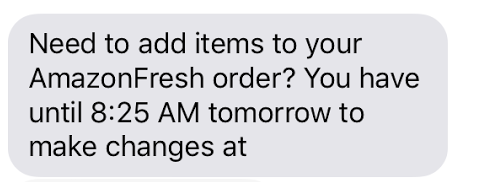
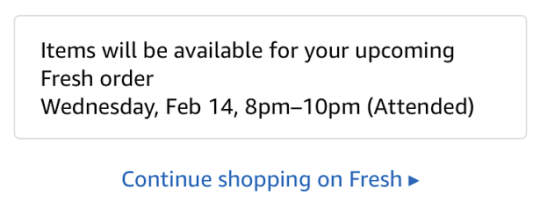
—
For the functional piece, Amazon relies on the ‘fresh order’ concept to help guide users along.
This is how they explain the process.
To add new items to an upcoming AmazonFresh order:
- Go to the AmazonFresh store and add items to the Fresh cart
- Once you are done, select Add to Fresh Order


So with this flow, your ‘order’ becomes like another cart. During the ‘time-window’ you’re able to add things to it, review it, and confirm you’d like to pay for it.
After you update your order, you see this message.
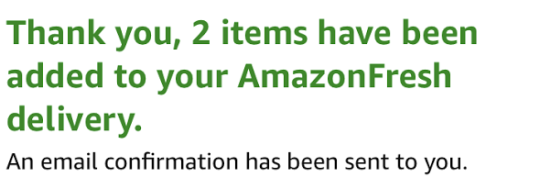

And, since I’m still within the ‘time window’, I’m able to review, edit or add more items to the order.
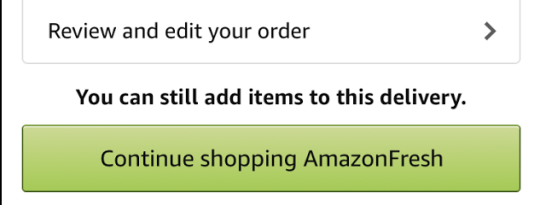
The concept is enforced in other ways including (visual design, language - “Add to your order”, “Done with order changes”, and other additional data like the countdown timer). Consistency is really important.
Use concepts as your ‘unit of design’, as a way to introduce complex functionality to your product.
On Blame
I hadn’t put much thought towards the concept of blame until reading the fantastic ‘Gentle Art of Verbal Self-Defense’ by Suzette H Elgin.
It’s a simple read, primarily focused on defending yourself against verbal attacks. Arguments between teachers and students, car mechanics and doctors are used to show how status and different communication styles can affect outcomes.
One of the things I found really interesting was the authors use of ‘Satir modes’, a set of behavioral archetypes developed by the therapist Virginia Satir.
The types include familiar characters like the ‘placater’ and the ‘computer’ but one that stood out to me most was the ‘blamer’, a style everyone will recognize. It’s the most obvious ways to argue, and one of the dumbest too.
The author explains, “the Blamer feels that nobody cares about him or her, that there is no respect for affection for him and that people are indifferent to his needs and feelings. The Blamer reacts to this with a verbal behavior pattern intended to demonstrate that he or she is in charge, is the boss, is the one with the power”.
A few tells that you’re dealing with a blamer.
“Nobody around here ever pays any attention to me.”
“Why don’t you ever think about what I might want?”
“You never consider my feelings.”
You can quite easily role play these modes against each other. A blamer will steam roll over the placater, making them feel worthless. A blamer against a computer, who takes a neutral or more sophisticated poistion will struggle to win. Blamer vs blamer is also an obvious disaster.
“When two Blamers talk to each other (two people who believe they have been wronged, they are more important etc) the conversation is a rapid road to a screaming match, nasty in every way.”“
Although the examples have dated a bit, and it’s clearly framed around housewives in the 70′s who are treated like shit by their husbands, the book had many practical lessons. The biggest one is that Blaming is ego fueled nonsense, and best to avoid at all costs.
In most cases, if you have to go head to head against a “blamer”, your best bet is usually to remove your ego as much as possible and to counter with Boring facts and high ground stuff. Make it about them, don’t take the bait.
Never blame.
Selina Meyer on blame
Here’s an example from an episode of Veep of blaming going wrong.
For background, Senator Doyle tells Selina (Vice President) to dump universal childcare and play it safe by putting the AARP onstage during her speech. When she refuses, he threatens to pull his support.
Doyle: I just got off the phone with the congressional leadership and they’re stuck in traffic, so we may not make it to the steps.
Selina: Are you threatening me? No.
Doyle: Traffic is really bad, so the car might be stuck there forever.
Selina: So I’m supposed to let a bunch of dead-eyed white guys shit all over absolutely everything that I stand for. I’m not going to let the party dictate to me!
Doyle: Huh? Okay.
Doyle’s opener is loaded with presuppositions. On the surface, it might sound like a helpful bit of information that he’s sharing. But that’s bullshit. He’s really saying. I’m in control of this situation. The people that you need listen to me, and will do what I say. The stress is on the word ‘may’, which means, this doesn’t need to happen, if you follow my requests.
The VP does not take the bait, ignores the phony traffic thing, and responds correctly to Doyle’s subtext. But she does so in a highly aggressive ‘blaming’ attack. Classic blamer feeling slighted.
Here is where it gets interesting. You can see everything in Doyle’s opener is neutral and reasonable (on paper). So he sticks in neutral mode. ‘Forever’, is him having a bit of fun with the situatuon, and is another jab at the VP.
The VP totally flips out, rages against Doyle, blaming and screaming. Again, she’s correctly identified the situation, she’s knows there’s nothing she can do, she knows she’s digging a hole and sounding crazy while Doyle stands by bemused, yet she does it anyway.
Doyle easily wins the encounter, and walks away shaking his head.
The VP’s staff look on with pitying expressions at the powerless VP who just got knocked about by a crusty old Senator.
John Maeda on Blame
“Don’t speak ill of others. It’s human nature to knock the other party down when they aren’t watching as a natural survival instinct. I always admire the people I meet in life who never feel they have to speak ill of others to make themselves look good.” - John Maeda (1999)
Marcus Aurelius on Blame
“If someone is slipping up, kindly correct them and point out what they missed. But if you can’t, blame yourself—or no one.” - Marcus Aurelius (Meditations, 10.4)
Dale Carnegie on Blame
The first rule of his infamous guide to win friends and influence people is…
“Don’t Criticize, Condemn or Complain.”
Note the alliteration here to help memorability. Dude was a pro.
Robin Dreeke on Blame
Robin is a FBI agent turned author. He’s a goofball, and his books are cringey, but his core message about ‘ego suspension’ to gain trust and lower shields, is a useful example of what happens when you bite your tongue in highly charged situations.
Here’s a story of a deescalating a road rage confrontation.
“My initial inclination was to demonstrate to the truck driver that he was overreacting and he was wrong. Making a vulgar gesture, flashing a badge, yelling…All of these actions are nothing more than egos battling for supremacy.”
“The truck driver pointed his finger at me as he exclaimed, “It’s idiots like you who cause accidents!” I continued to keep my ego suspended as I received the verbal abuse. My response was simple and contrite. “I know, I said I’m sorry.” The truck driver looked positively exhausted. He was clearly anticipating a confrontation and what he got was someone who was agreeing with him.“
Suspending your ego, and generally being less reactive, is one way to avoid taking the bait and rolling in the mud.
Aristotle on Blame
Aristotle dealt quite the challenge to humanity when he issued his moral philosophy about the ‘perfect man,’ saying he does not “concern himself that others should be blamed.”
John Barlow on Blame
From his list of 25 principles of adult behavior.
2. “Assign responsibility. Never blame.”
I could keep going. But the lesson here isn’t that blaming should be avoided, that’s obvious. It’s more learning to observe yourself, and training yourself to respond in smarter ways.
It’s hard. Our brains are wired to react emotionally. You can blame the amygdala for that. To restrain yourself and quickly reorient, especially in charged situatiuons, will take a bit of work.
For me, learning to blame less has been hard, but rewarding. Like the practice of mediation, every time you bring yourself back to the breath is one rep. And it takes a lot of reps.
So, every time you feel like you should stomp on someone, and put them in their place, prove someone wrong or simple point an accusatory finger — Don’t. Keep your mouth shut.
That’s one rep.